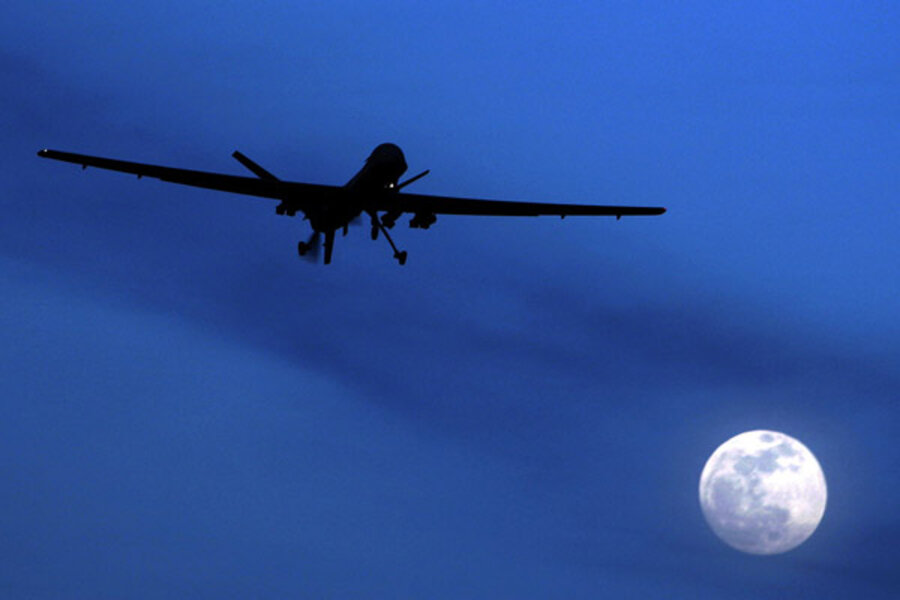US drone strikes again. Is Pakistan's military angling for a favor?
Loading...
| Washington
Does the resumption of US drone strikes inside Pakistan this week, after a hiatus of nearly two months, mean the two wary and fractious allies have mended fences?
Outwardly, US-Pakistan relations show no obvious improvement. Pakistan has stuck by two steps it took to retaliate against the United States after a deadly NATO attack on a Pakistani border outpost in November. Its border crossings into Afghanistan remain closed to NATO supply convoys, and US drones remain banned from Pakistan's Shamsi air base in the Baluchistan region.
But the US drone strike Tuesday in Pakistan's North Waziristan, which killed four suspected terrorists, does indicate an easing of tensions and a measure of resumed cooperation, at least between the militaries of the two “strategic partners,” some South Asia experts say.
Some even wonder if there's a connection between Tuesday's strike and Pakistan’s civilian-military political crisis, which may be reaching its denouement.
"My sense is that the two militaries were working behind the scenes to try to repair relations that remain crucial to both sides,” says Lisa Curtis, a senior fellow at the Heritage Foundation’s Asian Studies Center in Washington. “The resumption of drone strikes at this time does seem to suggest they were able to reach some kind of understanding.”
The common point in any understanding may well be that the US drone strikes, despite the Pakistani public's extreme dislike of them, serve the interests of both governments.
“We know how important the drone strikes have been for the US in the fight against Al Qaeda” and against Pakistan-based militants who cross the border to fight NATO and Afghan troops in Afghanistan, says Ms. Curtis. “And, in fact, they’ve been important for Pakistan in its fight with the antigovernment militant groups it faces.”
The US suspended the drone strikes, a deep source of ire inside Pakistan, in mid-November, after a NATO attack on a Pakistani border outpost killed 24 Pakistani soldiers and brought bilateral relations to the breaking point. US officials confirmed this month that the attacks had been suspended to allow time for frayed relations to mend.
Al Qaeda and other extremist groups appeared to take advantage of the lull in drone attacks, regrouping after having been splintered by a steady barrage of surprise missile fire, US officials say.
It is not clear if Tuesday’s attack means drone strikes have resumed in full, or if the targets in the North Waziristan strike were simply too valuable to pass up. The CIA, which operates the drones, has a policy of not commenting on its drone operations.
The Pakistani military, Curtis says, has probably angled for a slowdown in the pace of drone attacks, which reached more than two a week in 2010 before falling back somewhat in 2011.
“The Pakistanis have probably requested that [the US] be more measured in the tempo of [the drones'] use,” she says.
But Curtis, an expert in US-Pakistan relations, sees another possible reason for the Pakistani military to let US drones strikes resume at this time: It may be positioning itself to receive the US military’s support in any eventual role it plays in Pakistan’s ongoing civilian-military crisis.
“What they may be looking for is US acquiescence for what they may be trying to do, which may be trying to unseat the ... government” of President Asif Ali Zardari, she says.
Pakistan has been embroiled for months in a political crisis that pits its powerful military against a weak civilian government over corruption charges involving President Zardari. Zardari supporters insist that Pakistan's own military is out to bring down the government. On Tuesday, accusations flew that the country’s Supreme Court is siding with the military, after the court warned that it might dismiss Prime Minister Yousuf Reza Gilani if he does not begin corruption proceedings against Mr. Zardari.
The court’s pronouncement heightened the sense in Pakistan that the crisis is coming to a head. The return of drone strikes now suggests to some experts that there may be a connection.
“What we may be witnessing,” Curtis says, “is the Pakistani military’s realization that it would be more difficult to count on US support [for any action it takes in the political crisis] if they remain intransigent on what, for the US, are critical counterterrorism measures.”
The State Department has resisted commenting publicly on the political crisis there. "It's obviously an internal matter for Pakistan to settle," said spokeswoman Victoria Nuland in a briefing Wednesday. The US continues to have "broad contact" with all sectors of the Pakistani leadership, she said.







